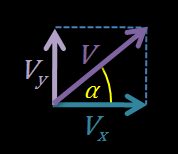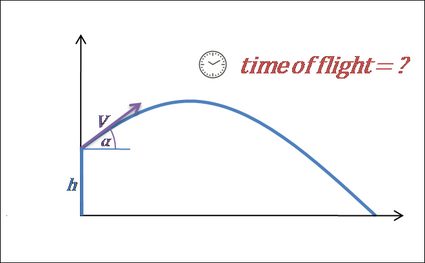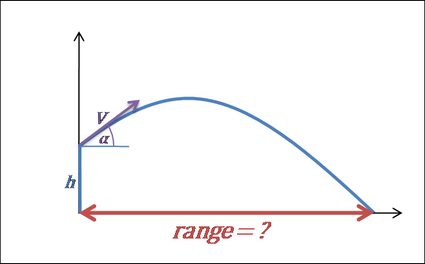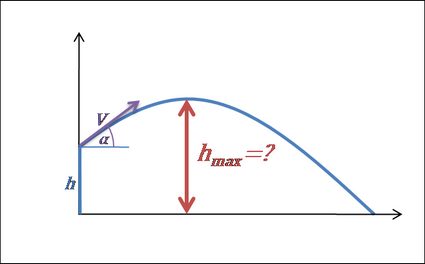What Horizontal Distance Does It Travel Before Hitting the Ground Again
Projectile Motion Calculator
Created by Bogna Szyk and Hanna Pamuła , PhD candidate
Reviewed by
Steven Wooding and Jack Bowater
Last updated:
Oct 05, 2021
- What is projectile motion? Projectile motion definition
- Projectile motion analysis
- Projectile motion equations
- FAQ
Our projectile motion estimator is a tool that helps you lot analyze the parabolic projectile motility. It tin can find the time of flight, but also the components of velocity, the range of the projectile, and the maximum peak of flight. Go along reading if y'all want to understand what is projectile motion, get familiar with the projectile motion definition, and determine the abovementioned values using the projectile motion equations.
What is projectile move? Projectile motion definition
Imagine an archer sending an arrow in the air. Information technology starts moving up and forward, at some inclination to the ground. The further it flies, the slower its ascent is – and finally, it starts descending, moving now downwards and forrad and finally hit the ground over again. If y'all could trace its path, it would be a curve called a trajectory in the shape of a parabola. Whatsoever object moving in such a way is in projectile move.
Only one force acts on a projectile – the gravity force. Air resistance is always omitted. If you lot drew a free body diagram of such an object, you would simply have to draw one downwards vector and denote it "gravity". If there were any other forces interim on the body, and then – by projectile move definition – it wouldn't exist a projectile.
Projectile motility analysis
Projectile motion is pretty logical. Let'due south assume y'all know the initial velocity of the object V, the bending of launch α, and initial tiptop h. Our projectile movement figurer follows these steps to notice all remaining parameters:
- Calculate the components of velocity.

- The horizontal velocity component
Vxis equal toV * cos(α). - The vertical velocity component
Vyis equal to5 * sin(α). - Three vectors -
V,VxandVy- form a right triangle.
If the vertical velocity component is equal to 0, then it'south the case of horizontal projectile motion. If, additionally, α = xc° then it'southward the instance of free autumn.
- Write down the equations of motion.
Distance
- Horizontal distance traveled can be expressed as
x = Vx * t, wheretis the time. - Vertical distance from the basis is described past the formula
y = h + Vy * t – one thousand * t² / ii, wheregis the gravity dispatch.
Velocity
- Horizontal velocity is equal to
Vx. - Vertical velocity can be expressed every bit
Vy – 1000 * t.
Acceleration
- Horizontal acceleration is equal to 0.
- Vertical acceleration is equal to
-g(considering just gravity acts on the projectile).
- Summate the time of flight.

-
Flight ends when the projectile hits the ground. We tin say that information technology happens when the vertical distance from the basis is equal to 0. In the case where the initial acme is 0, the formula can be written as:
Vy * t – thou * t² / 2 = 0. Then, from that equation, nosotros find that the fourth dimension of flight ist = two * Vy / g =2 * V * sin(α) / g. -
However, if we're throwing the object from some elevation, then the formula is not then nicely reduced as before, and we obtain a quadratic equation to solve:
h + Vy * t – g * t² / 2 = 0. After solving this equation, we get:t = [V * sin(α) + √((5 * sin(α))² + 2 * 1000 * h)] / g
- Calculate the range of the projectile.

-
The range of the projectile is the total horizontal altitude traveled during the flight time. Again, if we're launching the object from the basis (initial height = 0), then we can write the formula every bit
R = Vx * t = Vx * 2 * Vy / grand. It may exist also transformed into the grade:R = V² * sin(2α) / g -
Things are getting more complicated for initial elevation differing from 0. Then, we demand to substitute the long formula from the previous step every bit
t:R = Vx * t = V * cos(α) * [V * sin(α) + √(V * sin(α))² + 2 * g * h)] / m
- Calculate the maximum summit.

- When the projectile reaches the maximum height, it stops moving up and starts falling. It means that its vertical velocity component changes from positive to negative – in other words, information technology is equal to 0 for a brief moment at fourth dimension
t(Vy=0). - If
Vy – chiliad * t(Vy=0) = 0, so we can reformulate this equation tot(Vy=0) = Vy / g. - Now, nosotros only observe the vertical distance from the ground at that time:
hmax = Vy * t(vy=0) – g * (t(Vy=0))² / 2 = Vy² / (2 * g) = V² * sin(α)² / (2 * g) - Fortunately in the case of launching a projectile from some initial height
h, nosotros need to merely add that value into the concluding formula:
hmax = h + V² * sin(α)² / (2 * g)
Projectile move equations
Uff, that was a lot of calculations! Let's sum that up to form the most essential projectile motion equations:
- Launching the object from the footing (initial height h = 0)
- Horizontal velocity component:
Vx = V * cos(α) - Vertical velocity component:
Vy = V * sin(α) - Time of flight:
t = ii * Vy / m - Range of the projectile:
R = 2 * Vx * Vy / 1000 - Maximum height:
hmax = Vy² / (2 * g)
- Launching the object from some elevation (initial pinnacle h > 0)
- Horizontal velocity component:
Vx = V * cos(α) - Vertical velocity component:
Vy = V * sin(α) - Fourth dimension of flight:
t = [Vy + √(Vy² + 2 * k * h)] / chiliad - Range of the projectile:
R = Vx * [Vy + √(Vy² + 2 * thousand * h)] / g - Maximum height:
hmax = h + Vy² / (2 * g)
Using our projectile movement estimator volition surely save you a lot of fourth dimension. Information technology tin also work 'in opposite'. For instance, enter the time of flying, altitude, and initial height and watch it do all calculations for you!
FAQ
Does projectile motion have to travel horizontally?
No, projectile motion and its equations cover all objects in motion where the only strength acting on them is gravity. This includes objects that are thrown straight upwards, those thrown horizontally, those that have a horizontal and vertical component, and those that are simply dropped.
What is an case of projectile motility?
Objects with projectile movement include: keys being thrown, a 300 kg projectile being thrown 90 grand by a trebuchet, a football existence kicked so that information technology no longer touches the ground, a diver jumping from a diving lath, an arms beat out the moment it leaves the barrel, and a auto trying to jump a span.
How can a projectile autumn effectually the Earth?
There is only one force acting on a projectile - gravity. This means that an object will eventually fall to Earth. But what nearly if the object is moving so fast horizontally that, past the fourth dimension information technology reaches the ground, the basis is no longer there? This is the principle that governs satellites.
How practise I detect acceleration in projectile motility?
There is only one force acting on an object in projectile move - gravity. This means that whatever alter in vertical speed is due to gravitational dispatch, which is 9.81 m/s2 (32.2 ft/s2) on Earth. In the horizontal management, there is no change in speed, as air resistance is causeless to exist negligible, so acceleration is 0.
What factors touch on the motion of a projectile launched horizontally?
Initial velocity, the initial height the projectile is beingness launched from, and gravity will all affect a projectile launched horizontally. Air resistance will also have an consequence in existent life, but for most theoretical calculations it is negligible and is therefore ignored. If the projectile has wings, this will too impact its move, as it will glide.
What exactly is a projectile?
A projectile is an object that is in motion, in the air and has no strength interim upon it other than the dispatch due to gravity (this means that it cannot be self-propelled). You can probably think of many examples: a thrown ball or a stone thrown from a trebuchet. Even the Moon is a projectile, with respect to the Globe!
What are the characteristics of projectile motion?
The properties of projectile motility are that the object'southward horizontal velocity does not change, that it's vertical velocity constantly changes due to gravity, that the shape of its trajectory will be a parabola, and that the object is non afflicted by air resistance.
Who first accurately described projectile motion and when?
Galileo was the first person to describe projectile motion accurately, by breaking down motility into a horizontal and vertical component, and realizing that the plot of any object'south motion would always be a parabola. He described it in his book, On Motion, published around the 1590s.
Why does a projectile follow a curved path?
An object follows a parabola because of how its two components of motility - the horizontal and vertical - are affected by gravity. The horizontal component is not affected by gravity at all, and and so changes in a constant, linear fashion. The vertical part, yet, is constantly afflicted by gravity, and then it volition increase in height, and so decrease, accelerating due to gravity.
Why is 45 degrees the optimal bending for projectiles?
The equation for the altitude traveled past a projectile being affected by gravity is sin(2θ)five2/thousand, where θ is the angle, v is the initial velocity and m is dispatch due to gravity. Bold that v2/one thousand is constant, the greatest altitude will exist when sin(2θ) is at its maximum, which is when 2θ = ninety degrees. This means θ = 45 degrees.
Bogna Szyk and Hanna Pamuła , PhD candidate
Flying parameters at given time

Source: https://www.omnicalculator.com/physics/projectile-motion
Belum ada Komentar untuk "What Horizontal Distance Does It Travel Before Hitting the Ground Again"
Posting Komentar